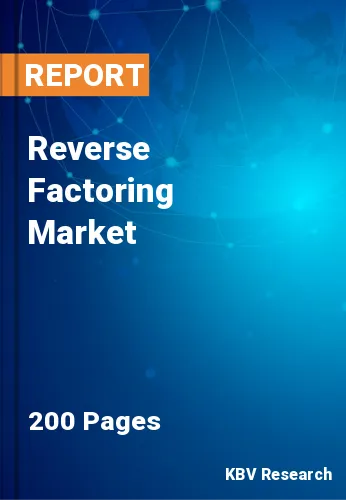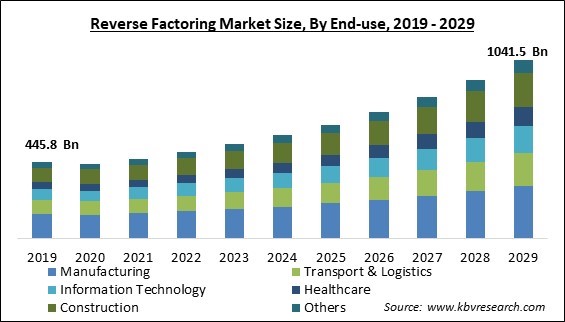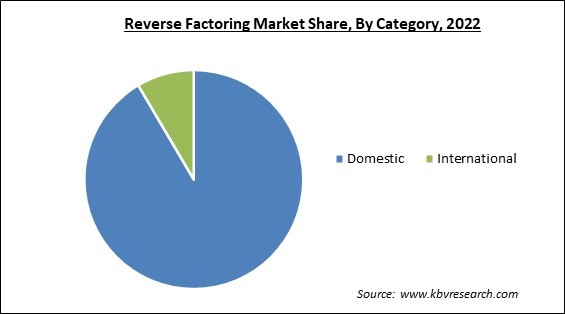
The Global Reverse Factoring Market size is expected to reach $1,041.5 billion by 2029, rising at a market growth of 11.3% CAGR during the forecast period.
Healthcare is a promising sector for reverse factoring because of company's increased investment in R&D activities to strengthen its product portfolio and market position. Hence, it is expected to capture approximately 1/5th share of the market by 2029. Healthcare industry manufacturers are undertaking a number of activities to grow their business operations. These programs, however, are costly and frequently in need of finance. Reverse factoring can assist healthcare companies in making the needed modifications to their business models and growing their operations when they are having trouble expanding their operations. The company's cash position has also improved via reverse factoring. Some of the factors impacting the market are an increase in the demand for safety and security in supply-chain operations, rising demand for reverse factoring among SMEs in emerging nations, and issues with the adoption of reverse factoring.

A rise in the demand for supply chain finance is being witnessed as a result of market manipulation. This can result in things like a loss of investor confidence, damage to market integrity, fraudulent behavioral patterning, as well as insider company pressure on financial institutions. Additionally, it gives the ability to collate and monitor multiple structured and unstructured data sets together and the ability to provide financial security to importers and exporters in the form of supply risk and payment risk. The market is expanding due to rising investments in reverse factoring financing technologies for tracking pre- and post-trade activities, as well as investigating cross-asset and cross-market exchanges within a limited number of firms. Additionally, several fintech companies are implementing supply chain finance systems to increase their income potential and boost customer satisfaction, which is driving the use of supply chain finance.
However, even though reverse factoring is common in some nations, it is evident that the practice's success is tied to the regulatory, legal, and tax difficulties that may prevent a factoring organization from joining the market. It is possible that the tax deductibility of interest on supply chain financing arrangements, the treatment of VAT, the difficulties of bankruptcy law, and cross-border capital controls are some of the most crucial problems that need to be handled once and for all.
Based on category, the market is characterized into domestic and international. The domestic segment garnered the highest revenue share in the market in 2022. Due to SCF services' effectiveness, domestic MSMEs are increasingly adopting them, which might be related to the segment's growth. The majority of suppliers worldwide are MSMEs, or Micro, Small, and Medium-sized Enterprises. Buyers' late payments make it challenging for suppliers to maintain reliable manufacturing schedules. The problem is made worse by the suppliers' lack of access to alternative sources of financing, which has an impact on their overall company operations.

On the basis of financial institution, the market is classified into banks and non-banking financial institutions. The non-banking financial institutions segment recorded a significant revenue share in the market in 2022. The non-banking financial institutions (NBFIs) provide enhanced flexibility and transparency in their reverse factoring solutions and assist various firms in coping with the changing geopolitical climate and supply chain. These actions generate significant potential for the industry. To help their domestic as well as international clients' trade, NBFIs offer trade knowledge through digital solutions.
By end-use, the market is divided into manufacturing, transport & logistics, information technology, healthcare, construction, and others (retail, food & beverages, others). The manufacturing segment witnessed the maximum revenue share in the market in 2022. By giving suppliers the option of getting early invoice payments along with extending the supplier payment terms of the manufacturer, reverse factoring enhances cash flow. Supply chain financing services have a promising future since manufacturing firms in a variety of industries, including chemical, welding, pallet, metal & machinery, and plastics & polymers, use reverse factoring services.
| Report Attribute | Details |
|---|---|
| Market size value in 2022 | USD 504 Billion |
| Market size forecast in 2029 | USD 1041.5 Billion |
| Base Year | 2022 |
| Historical Period | 2019 to 2021 |
| Forecast Period | 2023 to 2029 |
| Revenue Growth Rate | CAGR of 11.3% from 2023 to 2029 |
| Number of Pages | 200 |
| Number of Table | 360 |
| Report coverage | Market Trends, Revenue Estimation and Forecast, Segmentation Analysis, Regional and Country Breakdown, Companies Strategic Developments, Company Profiling |
| Segments covered | Category, Financial Institution, End-use, Region |
| Country scope | US, Canada, Mexico, Germany, UK, France, Russia, Spain, Italy, China, Japan, India, South Korea, Singapore, Malaysia, Brazil, Argentina, UAE, Saudi Arabia, South Africa, Nigeria |
| Growth Drivers |
|
| Restraints |
|
Region wise, the market is analyzed across North America, Europe, Asia Pacific, and LAMEA. The Europe segment acquired the highest revenue share in the market in 2022. Increased company activity levels, the availability of timely expert assistance for financial management from the majority of the enterprises, and the strong penetration of the market participants in this region may all be credited for the significant growth of the market in Europe. In addition, positive market prospects are being created in Europe by encouraging government efforts to help startups raise public and private finance and focus on existing reverse factoring solution providers on providing alternative financial aid by purchasing SMEs' pending bills.
Free Valuable Insights: Global Reverse Factoring Market size to reach USD 1041.5 Billion by 2029
The market research report covers the analysis of key stake holders of the market. Key companies profiled in the report include HSBC Holdings plc, Barclays PLC, JPMorgan Chase & Co., Banco Bilbao Vizcaya Argentaria SA, Deutsche Factoring Bank GmbH & Co. KG (Deutsche Leasing), Drip Capital Inc., PrimeRevenue, Inc., Trade Finance Global, Tradewind GmbH, and Credit Suisse Group AG.
By Category
By Financial Institution
By End-use
By Geography
The Market size is projected to reach USD 1,041.5 billion by 2029.
An increase in the demand for safety and security in supply-chain operations are driving the Market in coming years, however, Issues with the adoption of reverse factoring restraints the growth of the Market.
HSBC Holdings plc, Barclays PLC, JPMorgan Chase & Co., Banco Bilbao Vizcaya Argentaria SA, Deutsche Factoring Bank GmbH & Co. KG (Deutsche Leasing), Drip Capital Inc., PrimeRevenue, Inc., Trade Finance Global, Tradewind GmbH, and Credit Suisse Group AG.
The Banks market has acquired the maximum revenue share in the Market by Financial Institution in 2022 thereby, achieving a market value of $798.4 Billion by 2029.
The Transport & Logistics market has shown the high growth rate of 11.7% during (2023 - 2029).
The Europe market dominated the Market by Region in 2022 and would continue to be a dominant market till 2029; thereby, achieving a market value of $520.7 Billion by 2029.
Our team of dedicated experts can provide you with attractive expansion opportunities for your business.
